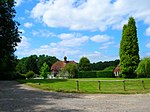Linch
Chichester DistrictVillages in West Sussex

Linch is an Anglican parish, and a loose collection of hamlets that make up the civil parish of the same name in the Chichester District of West Sussex, England, 5 miles (8.0 km) northwest of Midhurst. It has an eighteenth-century church dedicated to St Luke.
Excerpt from the Wikipedia article Linch (License: CC BY-SA 3.0, Authors, Images).Linch
Linch Road, Chichester
Geographical coordinates (GPS) Address Nearby Places Show on map
Geographical coordinates (GPS)
| Latitude | Longitude |
|---|---|
| N 51.04065 ° | E -0.77201 ° |
Address
St Lukes Church, Linch
Linch Road
GU30 7NF Chichester
England, United Kingdom
Open on Google Maps








